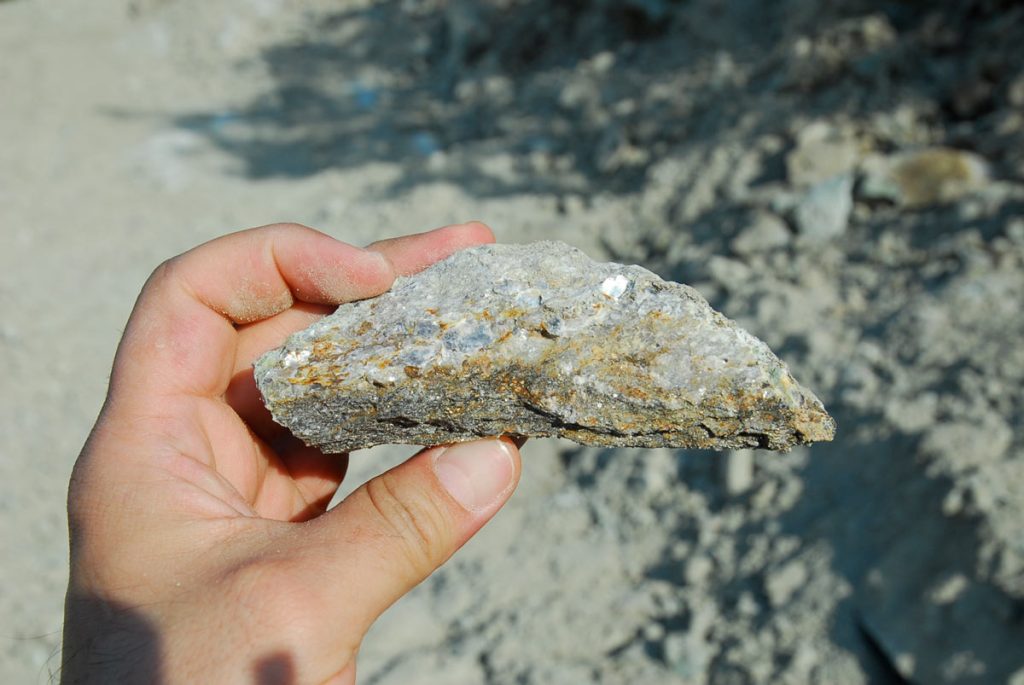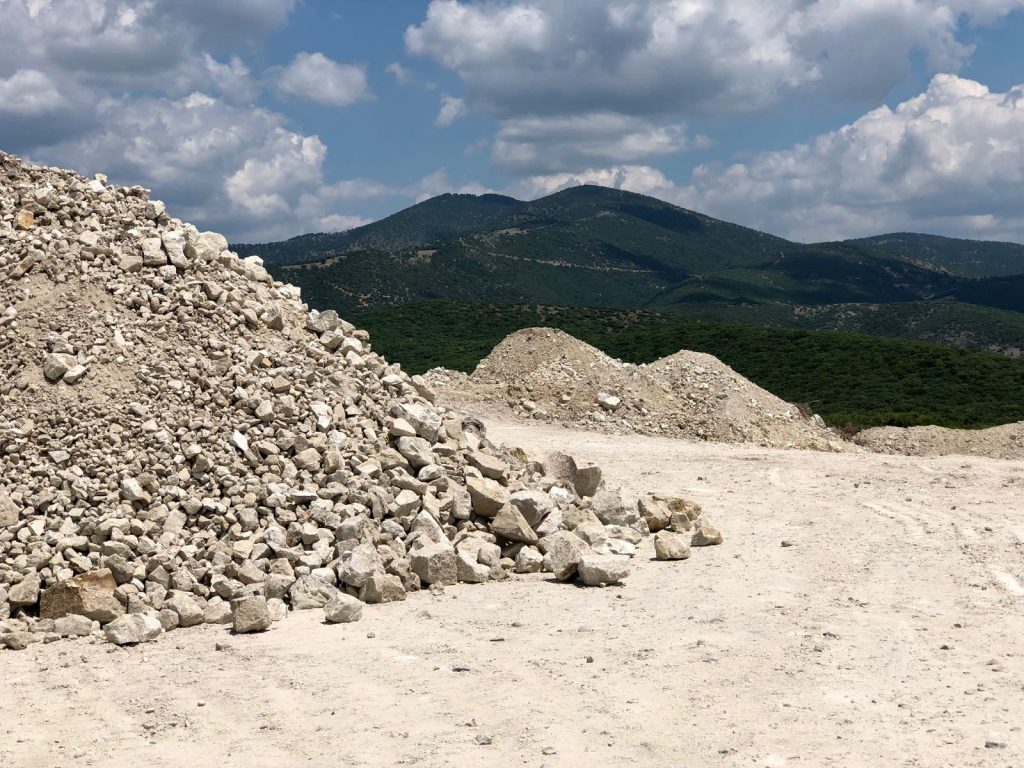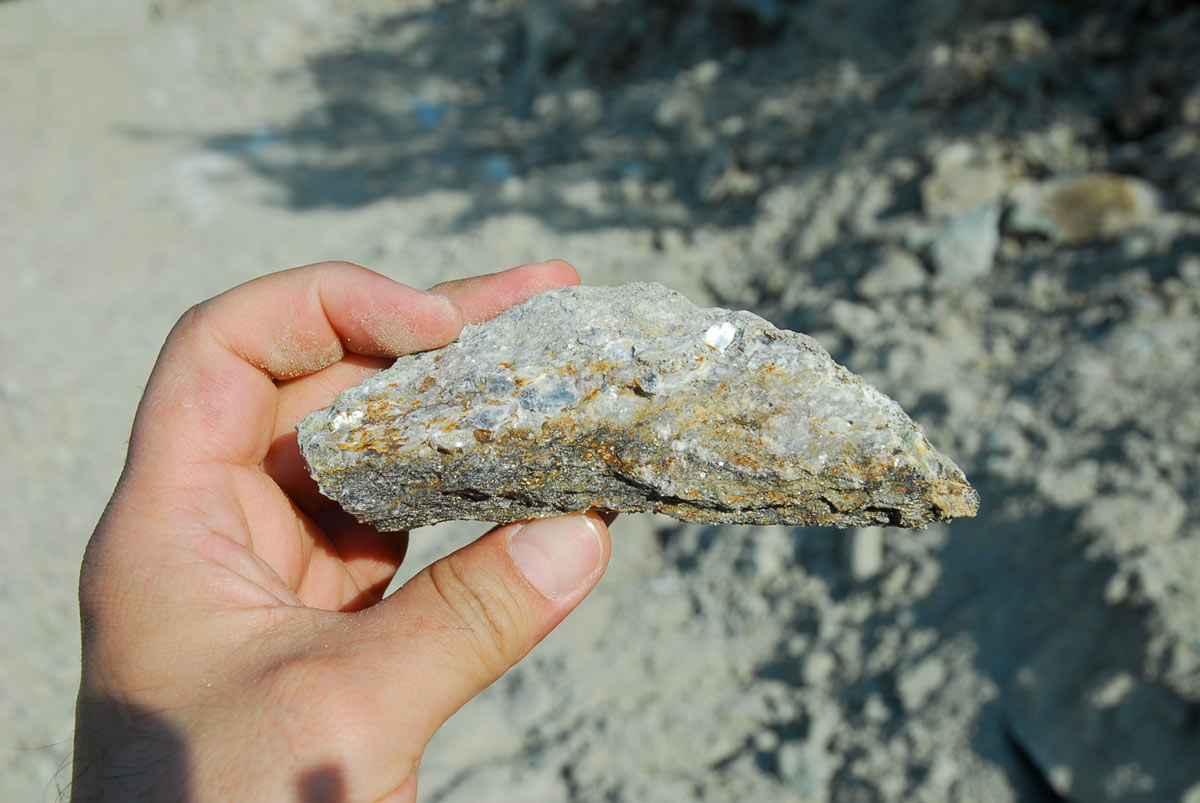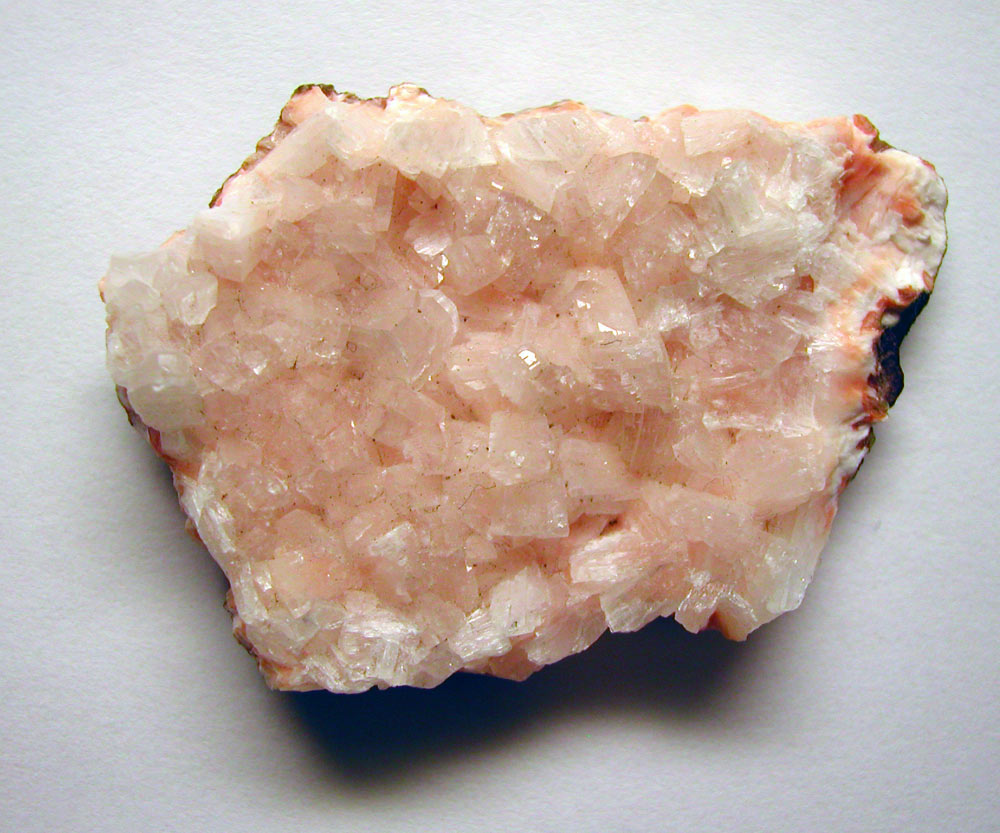Zeolite, this unique volcanic mineral with amazing cleansing and pollutant-binding properties, is not new to Greece. The first references to the use of zeolite date back to antiquity, when Greeks harnessed the power of natural rocks for hygiene, food storage, and water purification.
Today, Greek zeolite, especially from the Thrace region, is internationally recognized for its purity and composition in clinoptilolite. It is a material that bridges ancient wisdom with modern applications — from agriculture and livestock farming to detoxification and environmental protection.
Pink crystals of Eulandite (a type of zeolite) on a stony substrate. Zeolites are porous volcanic minerals formed by the weathering of volcanic ash in the presence of water and exhibit unique absorption and ion exchange properties.
Geological origin of zeolite in Greece
Zeolites are a group of natural clay-silicate minerals that are usually formed in areas of intense volcanic activity. In Greece, conditions during the Tertiary (66-2.6 million years ago) favoured the formation of zeolite deposits: recurrent volcanism with lots of pyroclastic material, high heat flow and a relatively dry climate leading to closed brackish basins. Volcanic ash and glassy powders in such environments were diagenetically altered in the presence of water, converting the original volcanic glass into zeolites (e.g. clinoptilolite, eulandite, mordenite) and associated minerals.
In Greece there are numerous occurrences of zeolites, especially in areas with volcanic rocks. Three main areas host large zeolite deposits of economic interest:
- Thrace ( Evros and Rodopi Prefecture) in the north-eastern part of the country, where the deposits are of Eocene-Oligocene age and rich mainly in eulandite and clinoptilolite. They are zeolitic tophiforms created by the hydrothermal alteration of volcanic ash in open freshwater and seawater hydrological systems.
- The islands of Kimolos and Polyeagos in the Cyclades, where the rocks are mainly of Quaternary age and rich in mordenite. There the zeolithization is probably related to high temperature hydrothermal fields due to recent volcanism.
- The island of Samos in the eastern Aegean, with Miocene deposits rich in clinoptilolite and analsimite. The samian deposits were formed in a closed brackish lake, with the zeolite being precipitated by alkaline lake water ( saline-alkaline type deposits ).
Apart from the above main areas, smaller occurrences of zeolites have been recorded in other volcanic zones. For example, in the pre-caldermal deposits of Santorini, zeolite from the weathering of volcanic tophi has been identified, while zeolitic volcanic rocks are also found in neogene basins of western Lesvos and elsewhere. In general, where there is old volcanic ash that has come into contact with water, there is the possibility of encountering natural zeolites.
In the Greek zeolitic toffs, the predominant zeolite mineral is clinoptilolite (of the orthorombic type HEU), often accompanied by eulandite – essentially the calcareous variant form of the same siding structural type. Other zeolites such as mordenite (in the Cyclades) and analsimite (in Samos) also occur in some places.
Zeolite in antiquity: early reports and uses
In ancient Greece the term “zeolite ” did not exist – it was invented much later. However, our ancestors used materials that we now know contained zeolites. Volcanic rocks and porous natural stones have been used since ancient times as building materials and soil conditioners. For example, historical sources mention that the Romans used the yellow Napolitan tuff (tuffo giallo napoletano) – rich in zeolitic minerals such as chavazite and phillipsite – to build buildings, and the entire city of Naples was built on this material.
The Romans also mixed volcanic ash (pozzolan) in lime mortars for the construction of hydraulic works, a practice probably given to them by empirical knowledge of the resistance of these materials in contact with water.
In Greece, archaeological research shows that the ancient Greeks and Thracians used various natural rocks with a porous structure.
In Thrace, for example, prehistoric quarries of flint and other stones have been found as early as the Neolithic period, while in the Classical period local tophi and sandstones were used as building materials. A typical example is the ‘chalky earth ‘ from the island of Kimolos – a white, clayey soil derived from weathered volcanic ash. Chalk earth has been known since antiquity and is mentioned by Theophrastus as a laundry material, being used to clean textiles and as a medicinal antidote thanks to its absorbent property. Although chalk earth refers mainly to clay minerals (e.g. smectites/bentonites) rather than zeolites, the practice of using volcanic products for cleaning and health purposes foreshadows the later use of zeolite in similar ways.
It is important to note that the word “zeolite ” itself has a Greek root, although it is not found in ancient texts. It comes from the ancient verb zeo (‘to boil’) and the noun lithos (‘stone’). The term was coined in 1756 by the Swedish mineralogist Axel Cronstedt, who observed that when a particular mineral is heated, water vapour is released and the mineral appears to ‘boil’. Inspired by the ancient Greek language, Cronstedt named the material zeolite, meaning ‘boiled stone’. The Greek language scientifically “christened” a material that the ancient Greeks probably used informally without naming it.
Although there is no direct written evidence from antiquity of deliberate use of zeolite, archaeological and folklore tradition suggests that the beneficial properties of such rocks did not go unnoticed. In Thrace, for example, locals observed for generations that cattle grazing on soils with zeolite subsoil gave richer and tastier milk, while fields near zeolite outcrops yielded more and better quality crops. In addition, spring water that gushed up through zeolitic rocks was considered extremely ‘sweet’ and pure: old housewives washed their clothes in such springs and observed a bleaching effect better than any other medium of the time. These traditions show that, long before zeolite was studied scientifically, societies intuitively recognised the value of the porous ‘boiling stones’ present in their locality.
Scientific discovery and study (18th-20th century)
The first scientific reference to zeolite was made, as mentioned above, in 1756 by Axel Cronstedt, inaugurating the official study of this mineral. During the 19th and 20th centuries , geologists discovered numerous new types of zeolites and investigated their properties.
By the middle of the 20th century, dozens of different natural zeolites had been identified – such as clinoptilolite, habazite, mordenite, analsimite, phillipsite, etc. – and at the same time synthetic zeolites (molecular sieves) were synthesised for industrial applications.
The unique ability of zeolites to selectively adsorb molecules, exchange ions and act as molecular sieves has stimulated interest in uses in water purification, catalytic processes and a host of other fields.
In Greece, systematic geological research for zeolites began in the 20th century, especially after the establishment of the Institute of Geological and Mineral Exploration ( IGME ). Although small occurrences were already known (e.g. on volcanic islands), the existence of large exploitable deposits was discovered relatively late.
An interesting early indication was Santorini: in 1981, geologist I. Kanaris of IGME reported the discovery of a zeolitic tophus on the island (in pre-caldera layers) in an internal report. This was one of the first official reports of a zeolite deposit on Greek territory.
The decisive progress came in the late 1980s, when IGME carried out an extensive research programme to identify zeolite occurrences throughout Greece. The results were revealing: large deposits of zeolitic tophi were identified in Thrace – specifically in areas of southern Evros (Petrota, Metaxades, Lefkimi, Feres, etc.) and in Rhodope (Skaloma site in the municipality of Arrianon).
Zeolitic zones were also confirmed on the islands of Kimolos/Polygos and Samos, in line with earlier indications. IGME’s investigations at some of these sites (e.g. Petrota-Metaxades) have shown that the tophi contain very high zeolite contents, with zeolite being a major component of the rock (over 70-80% w/w).
It is characteristic that in Petrota Evros a zeolitic tophus with clinoptilolite content up to ~89% was found, an extremely high percentage internationally. The Evros deposit was therefore rightly described as one of the cleanest and highest quality zeolite deposits in the world. In the Rhodope, at Skaloma, the zeolite was also found to be of ‘excellent quality ‘ (almost pure clinoptilolite). With this research by IGME, at the end of the 20th century Greece emerged on the “map” of countries with remarkable zeolite potential.
From an academic point of view, dozens of scientific studies have been carried out by Greek and foreign geologists on the Greek zeolitic rocks. Indicatively, papers have been published on the mineralogy and geochemistry of the Evros tophi, on the ion exchange capacity of Greek zeolites, as well as on their commercial potential. Professor M. Stamatakis of the University of Athens, together with foreign collaborators, published in 1996 a concise paper describing ‘the zeolite deposits of Greece’, highlighting the three regions mentioned above (Thrace, Kimolos/Polygon, Samos) and their geological conditions of formation. Thus, by the turn of the 21st century, the scientific basis of knowledge about Greek zeolite had been established: we knew where it was located, how it was formed and what its particular properties were.
Discovery of deposits in Thrace – from laboratory to practice
From the outset, the greatest interest was focused on Thrace, because of the size and purity of the deposits there. Already from the first results of IGME (late 1980s – early 1990s) it became clear that the area of Northern Evros (Municipality of Orestiada) hosts a “treasure”: extensive formations of high quality zeolitic tophi. In particular, zeolitic rocks were detected in 30 different locations in the prefecture of Evros, 10 of which are located in the Petroti-Pentalofos area. In 4 of these Petrotes locations, zeolite was detected with purity ranging from ~76% to 89% clinoptilolite. These are Eocene-Oligocene volcanic sediments, up to 100 m thick, deposited in shallow marine/lunar basins and later subjected to weathering processes by meteoric and seawater circulation.
The result was the formation of a porous, light rock where zeolite is the main component. These tuffs appear close to the surface, which facilitates mining (the zeolite ‘is found at a shallow depth, a few tens of metres below the ground’ , according to local sources). Total reserves in Evros are estimated at hundreds of millions of tonnes of zeolite material, making the region important on a global scale.
At the same time, further south in Thrace, in the prefecture of Rodopi, an exploitable deposit was also found. At the location ‘Skaloma ‘ (Municipality of Arrianon), about 70 km southwest of Petrotes, a zeolitic tophus of excellent quality was discovered. Geologically, Skaloma belongs to the same wider volcanic-sedimentary basin that extends in the Komotini-Organi-Sapes area.
IgME’s investigations there identified several occurrences of zeolite. In particular, three sub-areas (NW Skoloma, NE Skoloma and ‘Kerostatis’ location) were studied in detail and found to contain a cumulative total of about 5.2 million tonnes of natural zeolite reserves (1.0 + 1.7 + 2.5 million tonnes respectively). The Zeolite of Skaloma is mainly clinoptilolite-HEU, similar in composition to Evros, and therefore suitable for similar applications.
Laboratory tests carried out on samples from the Thracian deposits showed very high ion-exchange capacity (CEC) for zeolite, in the range of 200-400 meq/100g. Furthermore, the grain size and hardness of the material make it ideal for grinding and use in various forms (powder, granules). These characteristics paved the way for a multitude of industrial and environmental applications: from agricultural soil conditioners and feed additives, to water purification filters, heavy metal adsorbents, oil spill cleaners, cement and building material components, etc. In other words, the existence of this “Greek Natural Zeolite” (as it is often called) constituted a new valuable asset in the country’s mineral wealth, with potential for exploitation in many sectors.

Industrial utilization and the course of Greek zeolite until today
Despite the discovery of large zeolite deposits in Thrace already in the early 1990s, their industrial exploitation was not immediate. For several years, Greek zeolite remained unexploited, a fact that became a ‘mystery’ and gave rise to discussions both locally and nationwide. Since around 2003, various companies have expressed interest in obtaining mining licenses, particularly for the Evros Petroton deposit. However, the case developed into a long-lasting legal and administrative dispute. As a 2013 investigation revealed, the zeolite issue “plagued the local community for a decade” and had pitted the Ministry of Environment against the Decentralised Administration, involving politicians, IGME and even the Public Administration Inspectorate.
Specifically, two Thracian MPs (Alexandros Kontos and Euripides Stylianides) denounced in 2014 that “personal interests ” were preventing the exploitation of zeolite, leaving untapped a huge development opportunity for the agricultural sector and beyond. Indeed, it was found that a series of administrative obstacles (bureaucracy, overlapping responsibilities, annulment of decisions) had delayed the issuing of an exploitation permit. In fact, the company that was initially interested in Petrota appealed to the courts, while at the same time (according to reports) it was forced to import zeolite from abroad in order to meet the needs of the Greek market. It is noteworthy that in the period 2007-2009, zero or minimal domestic production (test mining of a few hundred tons) is reported, while at the same time Greece was consuming zeolite imported from countries such as Turkey, Bulgaria and Bosnia.
Despite the delays, important developments have taken place in recent years. Since 2019-2020, the competent authorities have completed the environmental and technical approvals for two major zeolite mining projects in Thrace: one in the prefecture of Rodopi and one in the prefecture of Evros. In Rodopi, at Skaloma, a public quarry area of ~98 ha was granted and an Environmental Impact Study was approved for a 20-year exploitation. This project was awarded to the company “Avgi Ltd”, which under the trade name “Thracian Zeolite ” started from the beginning of 2021 the extraction and processing of zeolite in an area of ~100 acres in Northern Greece.
Thus, for the first time, Greek clinoptilolite zeolite was officially put on the market, available for commercial use. At the same time, in Evros, the local community took action: a grassroots company was founded with the participation of local residents (” Petroton Zeolite S.A. – Lithoxos“), which received in 2021 approval of a technical study for a private quarry of 30 acres at the location “Palioklisi” Petroton. By the end of 2021, this project was also on track, marking the start of zeolite mining in Petrotta by the local residents themselves.
Today, therefore, the “Greek zeolite” is no longer an unfulfilled promise, but a reality in progress. It is already used in innovative applications: farmers in northern Greece incorporate it into fields to improve soil moisture and fertility, farmers add it to animal feed for better animal health, while it is also tested in wastewater treatment plants as a filter to remove pollutants. University research shows impressive results, e.g. increasing agricultural production by up to 66% using Thracian zeolite as a soil conditioner, and effective removal of heavy metals and ammonia from wastewater using Greek zeolite as a filter. In addition, Greek zeolite as an industrial mineral is being considered for the production of lightweight cements and mortars with better thermal insulation.

Going back in time from antiquity to the present day, we observe a fascinating journey: from the silent use of porous stones by our ancestors, to the scientific identification of zeolite in the 18th century, then to the discovery of the treasures of Thrace in the 20th century, and finally to industrial exploitation nowadays. Greek zeolite, with its roots literally and etymologically in the Greek land, is emerging as a material with enormous potential for the future. Armed with its unique properties and the support of both the scientific community and local communities, Greek zeolite can contribute to a more sustainable agriculture, a cleaner environment and new innovative products – writing the next chapter in its ever-evolving history.
Sources
Hellenic Geological & Natural Resources Authority Mineral Exploration (formerly IGME), scientific publications (Bulletin of the Geological Society of Greece, Mineralium Deposita), local and national press (To Vima, Evros News, Ypaithros), websites for information on zeolite, as well as archival material of mining companies (Zeolife, Thracean Zeolite, Zeolithos Petroton).
The references to historical observations and folklore testimonies come from the recorded experiences of the inhabitants of the Petroton area. In summary, the evidence confirms that Greek zeolite, from a ‘ boilingstone ‘ in the eyes of a Swedish mineralogist, has evolved into a valuable national resource with world-class characteristics.

